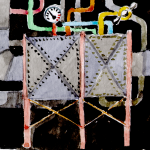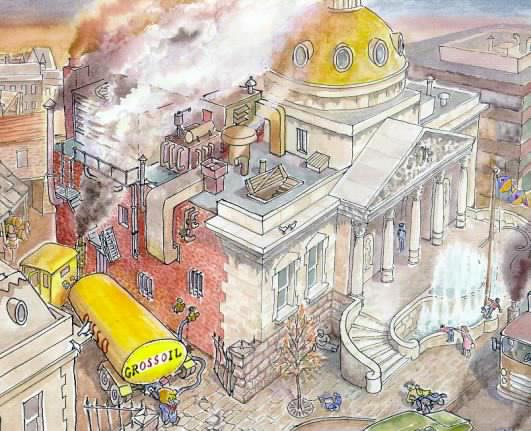
 |
Mechanical air conditioning |
The essential ingredients in an air conditioning system are a fan to blow air around, a cold surface to cool and dehumidify the air, a warm surface and a source of water vapour. In a large system there will also be a tangle of tubes to distribute the air and collect it again.
Notice that the cold surface has two independent jobs to do: it is used to cool the air and it is also used to dehumidify, by condensing water from the air. This means that the air is cooled more than is necessary for temperature control, so that it must be heated again afterwards.
Air conditioning wastes energy. It also wastes space, because air has to be pumped around in quite large tubes, so that it doesn't make a rushing noise. It does, nevertheless, generate a disturbing background noise if the room is otherwise quiet. There is worse news to come: air conditioning is spreading to more and more buildings in climates that we once thought were so mild that they would be immune.
The origin of this technological epidemic is not the subject of this article. I will however mention some reasons which are relevant to museum conservators (who are the intended target for this series of articles, but seem to be in a minority among the readers). Modern museums, and old ones as well, are showpieces designed to be admired for bold and original architecture. They tend to be massive, and those old museums which originally had courtyards to give light and air are now glassed over with domes and atria. The heat and moisture cannot easily escape to the outside: they have now to be pumped out.

The subtle elegance of buildings designed for their purpose counts for little nowadays. Grand Gestures are fashionable, and air conditioning hides the architects' and engineers' lack of understanding or respect for natural ventilation. One must say that conservators have reinforced this trend, because they have set specifications for allowable variation of temperature and relative humidity that can only be achieved by mechanical air conditioning.
The purpose of this article is to explain how air conditioning works, in order to show why one cannot just pluck values from some standard or recommendation without risking unexpected penalties in energy use, maintenance cost and noise. Furthermore, once the mess of steel boxes and ducts is installed, you cannot dial the temperature and humidity exactly as you want them without risking surprisingly expensive side effects of energy consumption, climatic instability and hidden condensation.

This work is licensed under a Creative Commons Attribution-Noncommercial-No Derivative Works 3.0 License.